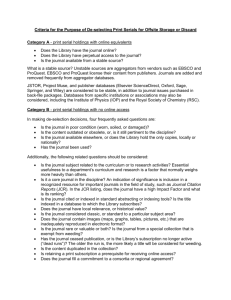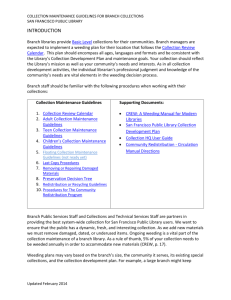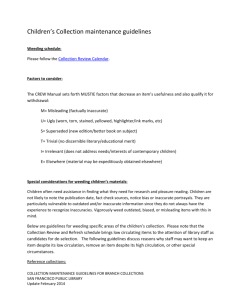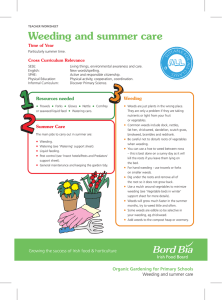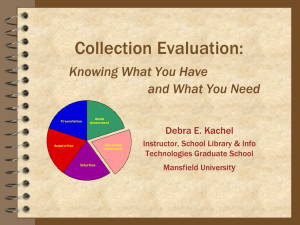Collection Development Goals - JF Drake State Technical College
advertisement
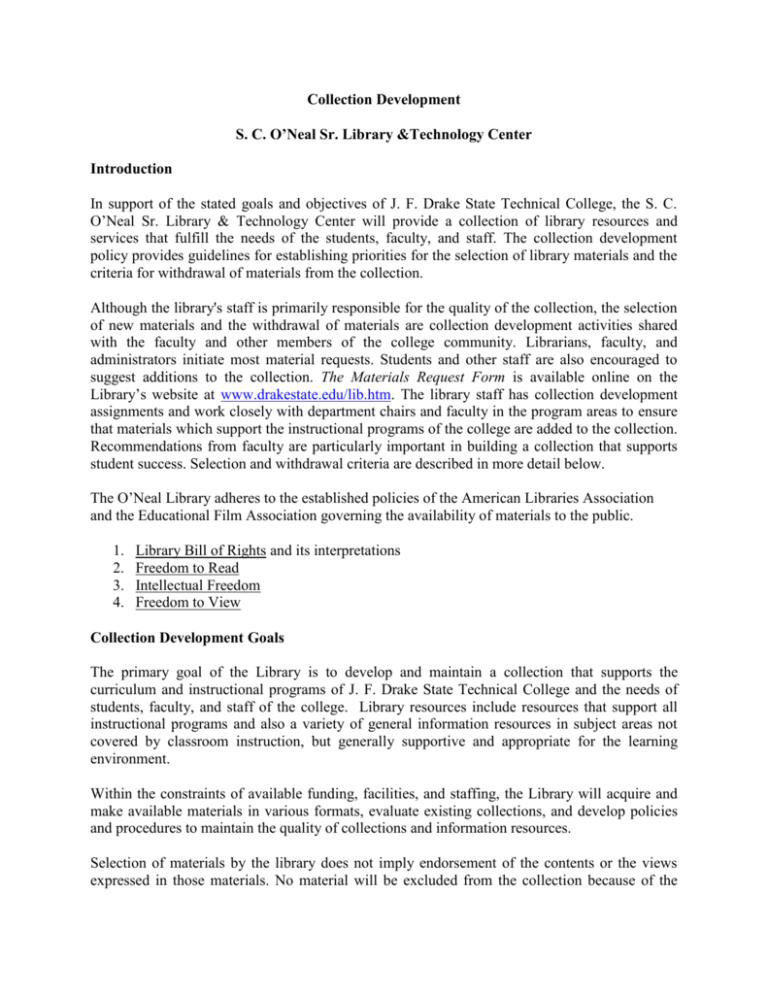
Collection Development S. C. O’Neal Sr. Library &Technology Center Introduction In support of the stated goals and objectives of J. F. Drake State Technical College, the S. C. O’Neal Sr. Library & Technology Center will provide a collection of library resources and services that fulfill the needs of the students, faculty, and staff. The collection development policy provides guidelines for establishing priorities for the selection of library materials and the criteria for withdrawal of materials from the collection. Although the library's staff is primarily responsible for the quality of the collection, the selection of new materials and the withdrawal of materials are collection development activities shared with the faculty and other members of the college community. Librarians, faculty, and administrators initiate most material requests. Students and other staff are also encouraged to suggest additions to the collection. The Materials Request Form is available online on the Library’s website at www.drakestate.edu/lib.htm. The library staff has collection development assignments and work closely with department chairs and faculty in the program areas to ensure that materials which support the instructional programs of the college are added to the collection. Recommendations from faculty are particularly important in building a collection that supports student success. Selection and withdrawal criteria are described in more detail below. The O’Neal Library adheres to the established policies of the American Libraries Association and the Educational Film Association governing the availability of materials to the public. 1. 2. 3. 4. Library Bill of Rights and its interpretations Freedom to Read Intellectual Freedom Freedom to View Collection Development Goals The primary goal of the Library is to develop and maintain a collection that supports the curriculum and instructional programs of J. F. Drake State Technical College and the needs of students, faculty, and staff of the college. Library resources include resources that support all instructional programs and also a variety of general information resources in subject areas not covered by classroom instruction, but generally supportive and appropriate for the learning environment. Within the constraints of available funding, facilities, and staffing, the Library will acquire and make available materials in various formats, evaluate existing collections, and develop policies and procedures to maintain the quality of collections and information resources. Selection of materials by the library does not imply endorsement of the contents or the views expressed in those materials. No material will be excluded from the collection because of the race, nationality, religion, gender, sexual orientation, political or social viewpoint or controversial nature of either the author or of the material. Guidelines for Selection of Materials The following guidelines are used to assist library staff, faculty, and administrators in selecting quality materials for inclusion in the Library collections. It is recognized that some of the criteria included in the guidelines are more important than others and that the quality of content should be a primary consideration. General factors to be taken into account are: Relevance to curriculum-based needs of students. Relevance to instructional needs of the faculty. Probable need based on existing programs and collections. Intellectual content and scholarly worth. Current, in-print publications will generally be given priority over out-of-print publications. Captioned or visually-described resources are to be preferred over non-accessible choices. First priority is given to resources which directly support subject areas and vocational emphases currently represented by credit courses offered by the College. Library staff and faculty work closely to ensure the selection of new works in the subject areas. Materials added to the collection are made accessible to the library users. A broad selection of publications will be used as selection tools, such as, catalogs of works of more important writers; a selection of the major review journals; and current editions of the most significant reference tools and bibliographies pertaining to the subject. The primary goal of the library's collections is to support the program of instruction. Textbooks adopted for class use are not purchased through the library’s budget but are secured through the College Bookstore. Textbooks are part of the reserve collection and follow in-house use policies. In addition to these general guidelines, policy statements for specific formats and areas of the collection are presented below. Reference Collection The reference collection is intended to meet the verification, location, and information needs of the college community by providing basic reference works in subject areas covered by the curriculum, as well as general information requests. The reference collection may include both print and electronic materials. Audiovisual and Electronic Materials Non-print media, including films, videocassettes, videodiscs, audiocassettes, computer application software, multimedia software, compact discs, online subscriptions, Internet access and CD-ROMs, may be relatively expensive. Selection of these materials should emphasize support for classroom instruction, as well as the quality, effectiveness, and currency of the material. Whenever practicable, faculty should have an opportunity to preview non-print media before a purchase decision is made. Whenever possible, selectors should negotiate a test or trial period for expensive media. For database subscription trials, departments should work with the Library staff. Listed below are general issues to be considered in the selection of non-print materials. 1. Content should directly support classroom instruction or be potentially useful for more than one class or department. 2. Treatment and presentation of subject content should be on an appropriate academic level. 3. Technical quality of color, sound, continuity, etc. 4. Cost effectiveness and durability and accessibility of the format (CD-ROM vs. on-line access or single user vs. network). 5. Cost and/or availability of appropriate equipment. 6. Cost and/or availability of sufficient technical support for maintenance of software and hardware. 7. The Library staff will designate as “circulating” or “reference” or “library use only” as appropriate. 8. See below for additional guidelines for the evaluation of electronic resources. 9. See below for Collection Development Policy for Internet Resources. Maps Maps are a very small part of the collection. Additional maps may be purchased as needed to provide direct support for classroom instruction and only at the request of the instructor. Atlases are available in the reference collection. Gifts The Library welcomes gifts of materials that are consistent with the collection development policy and provided that there are no restrictions attached as to their disposition. Because all items added to the collection generate processing and storage costs, materials received as gifts will be evaluated by the same criteria as materials purchased. Gifts are accepted with the understanding that materials not added to the collection will be disposed of in ways most advantageous to the library. Weeding Weeding, the removal of materials to be discarded is an important part of the overall collection development process. Building a viable collection of materials to serve the college community is a dynamic process that includes assessment and the removal of materials that are obsolete, damaged beyond repair, no longer relevant to the curriculum. Library staff with assigned areas of collection development responsibilities is primarily responsible for weeding the collection. Faculty members encouraged to review their subject areas to identify items which should be withdrawn and bring such materials to the attention of their library liaison. Guidelines for Weeding the Collection The following categories of materials will be considered for weeding from the collection. 1. Outdated materials. 2. Superseded editions. 3. Excessively worn or damaged materials. Items in poor condition, but still valuable in terms of intellectual content will be sent to the bindery for repair or considered for replacement. 4. Multiple copies of materials which are no longer needed to support the curriculum. The Library staff oversees weeding activities. Evaluating Electronic Resources Resource name Vendor/publisher name and address Vendor support: telephone # 24-hour service? Onsite service? Onsite training? Coverage & currency: dates of coverage update frequency cumulative or supplements? Audience: undergrad, grad., researcher, discipline Quality: Sample, demonstration, or review copy? Beta test or trial period? Reviews available? (attach reviews) Licensing considerations: limitations & restrictions Unique features Skills needed: (patrons and staff) Patron training needed Staff training needed Local needs for: acquisitions cataloging preservation archiving Collection Development Policy for Internet Resources and Databases I. Purpose The O’Neal Library supports the instructional program of the college by collecting or providing access to materials in multiple formats. One important e-resource, the Internet, and databases are readily available to any library user. However, while the Internet is easily accessible, careful selection of resources via the Internet is very important. Database resources are accessible through the internet and are the preferred resource to use. Electronic resources provide the following: 1. increase awareness of this type of library resource; 2. enhance and expand the Library's collection of traditional formats. II. General Selection Principles As with other materials the library staff works closely with faculty to: 1. consider present curriculum needs; 2. select materials which meet the standards the Library expects of all materials in regard to excellence, comprehensiveness, and authority; 3. consider the cost when recommending a particular database for inclusion over other possible acquisitions from material budgets. Specific format criteria: In addition to the content, program faculty should closely consider the criteria listed below when considering the addition of Internet resources or databases. the improvement or enhancement that the resource will give to existing print materials the broad accessibility of the resource under present copyright laws and licensing agreements the compatibility of the resource with existing or about to be purchased hardware in the Library on the campus the currency and relevancy of the resource's information the stability of the resource the user-friendliness of the resource III. Copyright The Library will comply with the existing copyright laws. The Library will also promote copyright compliance among its users and staff. IV. Licensing When applicable to Internet resources and databases, the Library will negotiate and comply with vendor licensing agreements. Notify Library staff about Internet resources/databases requiring a licensing agreement prior to selecting that resource. V. Provision of Access The Library will provide access to internet resources and databases at all times. When possible remote access will be available for usage away from the college. VI. Policy Review Because of the complex and dynamic nature of providing access to Internet resources, the Library staff will need to review this policy regularly. February 1, 2008

